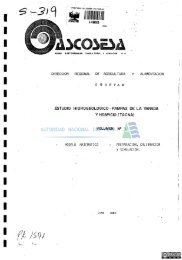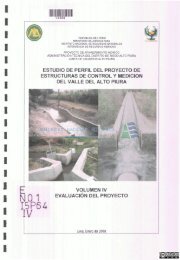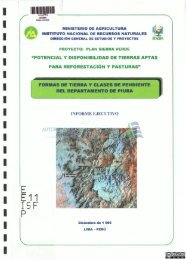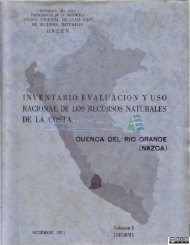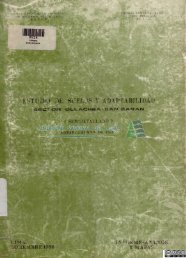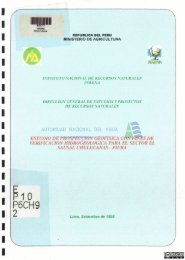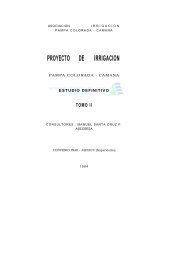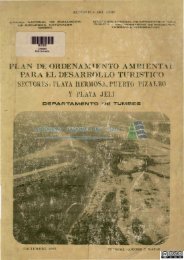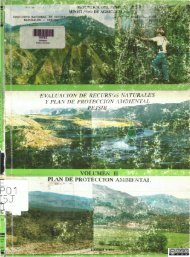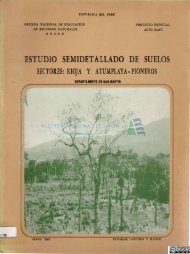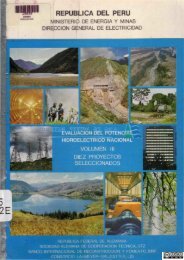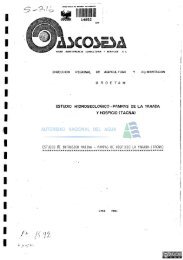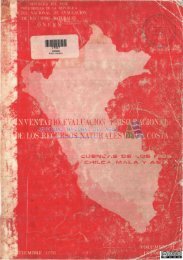P01 03 50.pdf - Biblioteca de la ANA.
P01 03 50.pdf - Biblioteca de la ANA.
P01 03 50.pdf - Biblioteca de la ANA.
- No tags were found...
Create successful ePaper yourself
Turn your PDF publications into a flip-book with our unique Google optimized e-Paper software.
146 ZONA ESPERANZA-CHAÑÓLES- YACOpaisaje ribereño <strong>de</strong> los ríos Curanja y Alto Purús, principalmente. Los suelos quecaracterizan a este tipo <strong>de</strong> bosque son aluviales muy recientes, <strong>de</strong> morfología estratificaday <strong>de</strong> muy escaso <strong>de</strong>sarrollo.Dentro <strong>de</strong> este tipo <strong>de</strong> bosque se ha i<strong>de</strong>ntificado 25 especies forestales diferentescon un volumen total estimado <strong>de</strong> 657,900 m3. y con un contenido volumétrico <strong>de</strong>ma<strong>de</strong>ra promedio por hectárea <strong>de</strong> 51 m3. que lo califica <strong>de</strong> bajo y, por consiguiente, <strong>de</strong> potencial 'fcobre". Asimismo, presenta 66 árboles promedio por hectárea ,recayendo el grueso <strong>de</strong> <strong>la</strong>s especies ma<strong>de</strong>reras al grupo <strong>de</strong> <strong>la</strong>s semipesadas y semiduras(alre<strong>de</strong>dor <strong>de</strong>l 70%). La aplicación <strong>de</strong> <strong>la</strong>s especies ma<strong>de</strong>reras que reúne seinclinan <strong>de</strong>finidamente al rubro <strong>de</strong>l aserrío con cerca <strong>de</strong> 35%, seguido <strong>de</strong> parquet,postes y durmientes con 27% y <strong>la</strong>minado con cerca <strong>de</strong>l 14%.Caracterización <strong>de</strong>l Bosque(a)Volumen <strong>de</strong> Ma<strong>de</strong>raLa composición <strong>de</strong>l bosque Calycophyllum - Guarea en base a <strong>la</strong>s especiesforestales con un mayor volumen ma<strong>de</strong>rable y que representa aproximadamente el 70% <strong>de</strong> volumen promedio <strong>de</strong> ma<strong>de</strong>ra por Ha. ascien<strong>de</strong> a 8, entre <strong>la</strong>sque <strong>de</strong>staca con un 32% <strong>la</strong>s siguientes: Calycophyllum spruceanum (capirona): 10.65 m3; Guarea sp. (requia)í 6.48 m3; Cordia sp. (ajos quiro):4.d4m3; Erythrina sp. (amasisa): 4.01 m3. El cuadro <strong>de</strong> <strong>la</strong>s especies ma<strong>de</strong>rerasque completan el 70% <strong>de</strong> vojumen <strong>de</strong> ma<strong>de</strong>ra por hectárea está tipifjcadopor <strong>la</strong>s siguientes; Coussapoa sp. (renaco); Trip<strong>la</strong>ris sp. (tangaranq); Trichiliasp. (uchumul<strong>la</strong>ca); Guatteria sp. (carahuasca). El <strong>de</strong>talle volumétrico<strong>de</strong> estas especies arriba indicadas y <strong>la</strong>s restantes 17 se indica en forma pormenorizadaen el Cuadro N 0 5 <strong>de</strong>l Anexo Forestales.El volumen total estimado, anteriormente seña<strong>la</strong>do (657,900 m3) ha permitído c<strong>la</strong>sificar a <strong>la</strong>s especies ma<strong>de</strong>reras incluic<strong>la</strong>s en este tipo <strong>de</strong> bosque <strong>de</strong> <strong>la</strong>siguiente forma:-Según C<strong>la</strong>ses Diamétrícas64.0% correspon<strong>de</strong>n a árboles con diámetros entre 25 y 50 cm.; 30.3% correspon<strong>de</strong>na árboles con diámetros entre 50 y 100 cm. y 5.7% correspon<strong>de</strong>na árboles con diámetros superiores a 1 metro (Cuadro N 0 3-F).-Según Alturas Comerciales24.2% correspondientes a árboles <strong>de</strong> 1 troza; 58.5% correspondientes a árboles <strong>de</strong> 2 trozas; 17.3% correspondientes a árboles <strong>de</strong> 3 trozas (Cuado N 0 3 -"F).



